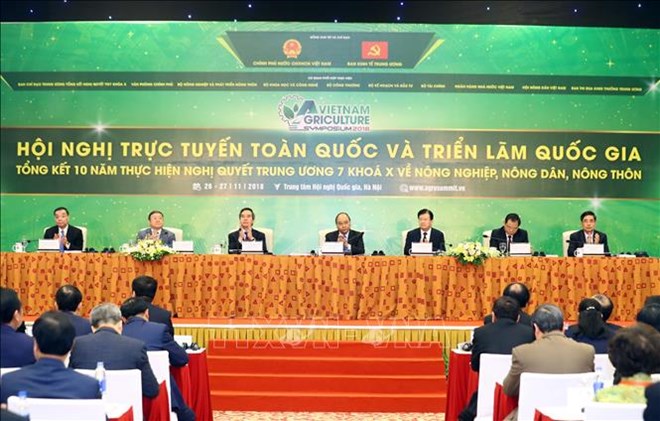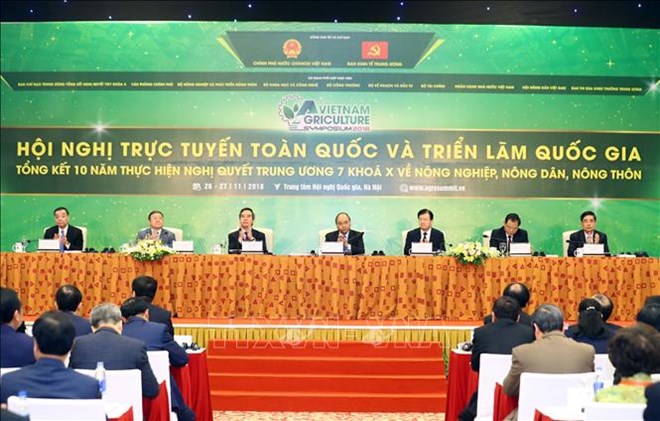
The settlement of issues regarding agriculture, farmers and rural areas is an important political task of the entire Party and people until 2020 and the years beyond, said a Party official.
At the teleconference
(Photo: VNA)
Nguyen Van Binh, head of the Party Central
Committee’s Economic Commission, was speaking at a national teleconference
reviewing the ten-year implementation of Resolution 26-NQ/TW on agriculture,
farmers and rural areas adopted at the seventh plenum of the 10th Party Central
Committee, which is also the first of its kind issued by the Party.
Prime Minister Nguyen Xuan Phuc, Deputy PM Trinh Dinh Dung and a large number
of representatives from ministries, agencies, sectors, foreign embassies and
international organizations also attended the event.
Binh stressed that President Ho Chi Minh and the Communist Party of Vietnam
(CPV) had always paid due attention to the development of agriculture, farmers
and rural areas, considering this important foundations and forces for national
socio-economic development and maintenance of political stability, security and
national defence.
Over the past decade, Vietnam has made great achievements in this field, which
are recognised and applauded by the international community, he said,
highlighting the improved role and position of farmers.
However, there still remain limitations regarding the organisation, quality,
efficiency and sustainability of agricultural production, rural economy and
new-styled rural area building, according to the official.
Due to the bottlenecks, some targets set by the resolution may not be fulfilled
by 2020 if no breakthrough solutions and timely, drastic instructions are
taken, he said.
Given this, Binh urged delegates to propose models and solutions to spur the
development of agriculture, farmers and rural areas in the time ahead, enhance
the Party’s leadership, improve the efficiency of State management, promote the
role of the Vietnam Fatherland Front and other socio-political organisations
and encourage the public’s participation in this regard.
At the conference, deputy head of the Party Central Committee’s Economic
Commission Cao Duc Phat presented a report on the ten-year implementation of
the resolution.
Earlier, Prime Minister Nguyen Xuan Phuc and representatives of ministries and
agencies cut the ribbon to open a national exhibition on agriculture, farmers
and rural areas.
With more than 100 booths, the exhibition introduces achievements Vietnam has
gained over the past ten years in this sphere, along with quality farm produce,
technologies and services in agriculture and agricultural startups.
As of late 2017, 34.4 percent of communes met the criteria on new-style rural
areas, which is expected to reach over 40 percent in late 2018 and 50 percent
in 2019.
According to the draft summing report that attests to the correctness of
Resolution 26, the agricultural sector accounts for nearly 70 percent of the
national population and 40 percent of the nation’s workforce.
Several goals for 2020 set in the resolution are likely to be fulfilled,
including raising the income of rural residents by more than 2.5 times compared
to present (per capita income in rural areas in 2017 was 32 million VND, up
3.49 times from 2008).
The agricultural sector will employ around 30 percent of the workforce by 2020
(the rate was 38.6 percent in June this year), while half of the communes
nationwide will achieve all criteria for new style rural areas.
Source: VNA
According to data from the Hoa Binh Provincial Party Committee, the industrial production index for the first six months of 2025 is estimated to have increased by 20% compared to the same period last year. This marks the highest year-on-year growth rate for this period since 2020.
In the first six months of 2025, Hoa Binh province’s export turnover was estimated at 1.145 billion USD, marking an 18.11% increase compared to the same period in 2024. Import turnover was estimated at $ 804 million, a 17.15% increase, which helped the province maintain a positive trade balance.
The lives of the ethnic minority farmers in Tan Lac district have gradually improved thanks to the new directions in agricultural production. This is a testament to the collective strength fostered through the professional associations and groups implemented by various levels of the district’s Farmers’ Union.
With the motto the "product quality comes first,” after nearly one year of establishment and operation, Muong village’s Clean Food Agricultural and Commercial Cooperative, located in Cau Hamlet, Hung Son Commune (Kim Boi district), has launched reputable, high-quality agricultural products to the market that are well-received by consumers. The products such as Muong village’s pork sausage, salt-cured chicken, and salt-cured pork hocks have gradually carved out a place in the market and they are on the path to obtaining the OCOP certification.
In the past, the phrase "bumper harvest, rock-bottom prices" was a familiar refrain for Vietnamese farmers engaged in fragmented, small-scale agriculture. But today, a new spirit is emerging across rural areas of Hoa Binh province - one of collaboration, organisation, and collective economic models that provide a stable foundation for production.
Maintaining growing area codes and packing facility codes in accordance with regulations is a mandatory requirement for agricultural products to be eligible for export. Recently, the Department of Agriculture and Environment of Hoa Binh province has intensified technical supervision of designated farming areas and packing facilities to safeguard the "green passport" that enables its products to access international markets.



